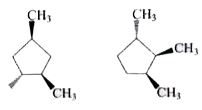For which of the following pairs of compounds are the correct notations given?




The correct Answer is:B, D
To solve the question regarding the correct notations for the given pairs of compounds, we will analyze each pair step by step.
Step 1: Analyze Pair A
- Notation Given: NT and Syn
- Explanation:
- Syn (or cis) indicates that substituents are on the same side.
- NT (or trans) indicates that substituents are on opposite sides.
- Observation: If both substituents (phenyl groups) are on the same side, then the correct notation should be Syn, not NT.
- Conclusion: This pair is incorrect.
Step 2: Analyze Pair B
- Notation Given: Syn
- Explanation:
- In this case, we have H and OH groups.
- If both H and OH are on the same side, this is indeed a Syn addition.
- Observation: The representation shows H and OH on the same side.
- Conclusion: This pair is correct.
Step 3: Analyze Pair C
- Notation Given: Anti
- Explanation:
- Anti indicates that substituents are on opposite sides.
- Observation: If H and OH are on opposite sides, this is indeed an Anti addition.
- Conclusion: This pair is correct.
Step 4: Analyze Pair D
- Notation Given: Cis and Trans
- Explanation:
- Cis indicates that substituents are on the same side.
- Trans indicates that substituents are on opposite sides.
- Observation: If HH are on opposite sides, it is Trans, and if they are on the same side, it is Cis.
- Conclusion: This pair is correct.
Step 5: Analyze Pair E
- Notation Given: E and Z
- Explanation:
- E indicates that the higher precedence groups are on opposite sides.
- Z indicates that the higher precedence groups are on the same side.
- Observation: If the higher precedence groups are on the same side, it is Z; if they are on opposite sides, it is E.
- Conclusion: This pair is correct.
Final Conclusion
- The correct pairs with their notations are:
- B: Correct (Syn)
- C: Correct (Anti)
- D: Correct (Cis and Trans)
- E: Correct (E and Z)
- Final Answer: The correct notations are for pairs B, C, D, and E.
- Notation Given: NT and Syn
- Explanation:
- Syn (or cis) indicates that substituents are on the same side.
- NT (or trans) indicates that substituents are on opposite sides.
- Observation: If both substituents (phenyl groups) are on the same side, then the correct notation should be Syn, not NT.
- Conclusion: This pair is incorrect.
- Notation Given: Syn
- Explanation:
- In this case, we have H and OH groups.
- If both H and OH are on the same side, this is indeed a Syn addition.
- Observation: The representation shows H and OH on the same side.
- Conclusion: This pair is correct.
- Notation Given: Anti
- Explanation:
- Anti indicates that substituents are on opposite sides.
- Observation: If H and OH are on opposite sides, this is indeed an Anti addition.
- Conclusion: This pair is correct.
- Notation Given: Cis and Trans
- Explanation:
- Cis indicates that substituents are on the same side.
- Trans indicates that substituents are on opposite sides.
- Observation: If HH are on opposite sides, it is Trans, and if they are on the same side, it is Cis.
- Conclusion: This pair is correct.
- Notation Given: E and Z
- Explanation:
- E indicates that the higher precedence groups are on opposite sides.
- Z indicates that the higher precedence groups are on the same side.
- Observation: If the higher precedence groups are on the same side, it is Z; if they are on opposite sides, it is E.
- Conclusion: This pair is correct.
- The correct pairs with their notations are:
- B: Correct (Syn)
- C: Correct (Anti)
- D: Correct (Cis and Trans)
- E: Correct (E and Z)
- Final Answer: The correct notations are for pairs B, C, D, and E.
Similar Questions
Knowledge Check
Which of the following pairs of compounds are not isomers?
APropan-1-ol and methoxyethaneBPropene and cyclopropeneCpropyne and propadieneDpropyne and cyclopropeneWhich of the following pairs of compounds are not position
isomers?A B
B C
C D
D
Which of the following pairs of compounds are not positional isomers ?
A B
B C
C DAll of these
DAll of these
Which of the following pairs of compounds are not isomers:-
View SolutionThe following pair of compounds are best described as

View SolutionWhich of the following pairs of compounds are position isomers?
View SolutionWhich of the following pairs of compounds is a pair of enantiomers?
View SolutionWhich of the following pairs of compounds are functional isomers?
View Solution
